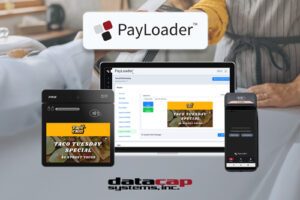 When it comes to driving loyalty in grocery, customer experience is king. Today’s consumers demand fast, convenient, personalized service. According to Oracle, 40 percent of shoppers say they would switch stores if they had one bad experience. One make-or-break touchpoint is the checkout. Most grocery shoppers want to find the items they need, pay for them, and get out the door. They don’t want to wait for the cashier to struggle with the payment transaction for the customer ahead of them, and they certainly don’t want their own checkout process to be clunky and time-consuming.
When it comes to driving loyalty in grocery, customer experience is king. Today’s consumers demand fast, convenient, personalized service. According to Oracle, 40 percent of shoppers say they would switch stores if they had one bad experience. One make-or-break touchpoint is the checkout. Most grocery shoppers want to find the items they need, pay for them, and get out the door. They don’t want to wait for the cashier to struggle with the payment transaction for the customer ahead of them, and they certainly don’t want their own checkout process to be clunky and time-consuming.
Grocers want efficiency at the point of sale, not complex, multi-step processes. As an ISV or VAR, when you recognize the need to deliver fast, efficient checkout processes, you will increase the value you provide to grocers and build stronger, lasting relationships with them, helping you grow your business.
Features that Optimize Grocery Payment Experiences
Grocery store operations are unlike any other retailer, and they need specific capabilities. Grocery payment solutions must include:
- Pre-Dip/Pre-Tap
Customers in grocery lines are busy placing items on the belt, entering loyalty information, passing reusable bags to the cashier, and putting bags in their carts — and, they’re usually in a hurry. They may prefer to put their cards into the payment terminal at the beginning of the process, rather than wait for the cashier to prompt them, so there isn’t any delay when it’s time to pay. Enable them to insert their cards and enter PIN, if required, when checkout begins.
- Line Item Detail on the Display
Budget-conscious customers want to watch as each item is scanned so they can check the price and keep track of the subtotal. They will also appreciate the opportunity to question whether the store applied promotional pricing. Give grocers the ability to be transparent with a line-item display that enhances customer grocery payments experiences and builds trust.
- Electronic Payment Method Choices
Grocers should accept all electronic payment methods their customers prefer, not only to enhance and personalize customer experiences, but to increase average sales. Shoppers may spend more when they know they can use their preferred payment type and not be limited by the cash in their pockets. Ensure merchants can accept all forms of grocery payments, including credit and debit, mobile wallets, like Apple Pay and Google Wallet, and contactless cards.
- EBT and eWIC Acceptance
A significant fraction of the population uses electronic benefit programs to purchase food. Over 42 million people use the Supplemental Nutrition Assistance Program (SNAP), with their benefits loaded on Electronic Benefits Transfer (EBT) cards. Another popular program, Special Supplemental Nutrition Program for Women, Infants, and Children (WIC), which 6.6 million people participate in, receiving their benefits on eWIC cards. Grocers who accept payments from these programs can expand their customer base and potentially increase foot traffic at their stores. They also may see increased sales of non-eligible items, which the customer pays for out of pocket.Although EBT and eWIC cards act like debit cards from the consumer’s perspective, grocers require specific solutions to accept them. They can use a standalone system, but EBT and eWIC payments integrated with the POS system are fastest and most efficient.
- FSA/HSA Acceptance
Many grocery stores carry a wide range of eligible health-related products, from over-the-counter medications and first aid supplies to vitamins and personal care items. Accepting Flexible Spending Accounts (FSA) and Health Savings Accounts (HSA) allows customers to conveniently use their pre-tax health benefits to purchase these items, increasing customer satisfaction and driving higher sales. By integrating FSA/HSA acceptance directly into the point-of-sale system, grocers can streamline the checkout process, reduce friction for customers, and encourage repeat business. Supporting these payment options also positions grocers as a one-stop shop for both grocery and wellness needs, enhancing customer convenience and loyalty. - BOPIS/Grocery Pickup
The rise of Buy Online, Pick Up In-Store (BOPIS) and grocery pickup services has transformed the shopping experience for busy customers. Shoppers expect a seamless, fast pickup process — including quick and secure payment options. Grocery payment solutions should support pre-payment through mobile apps or online platforms and enable quick in-person payment upon pickup if needed. Ensuring that BOPIS transactions are integrated with the POS system allows grocers to manage inventory more effectively, reduce wait times, and provide a smooth, convenient experience that encourages repeat business.
- Gift Cards
Grocery store gift cards are one of the most popular options, with three out of five consumers ranking them as their top choice for gift cards. Grocers need an efficient way to issue and accept them at the checkout, so gift card transactions don’t hold up the line. Furthermore, grocers will benefit from an omnichannel gift card solution that allows consumers to purchase and use gift cards online as well as in-store.
- Loyalty Rewards
Consumers participate in grocery store loyalty programs at a higher rate than with any other type of retailer. Earning gas discounts with grocery purchases is one popular reward, while a discount on groceries is also an effective incentive to keep customers coming back. Grocery payment solutions should have an integrated loyalty rewards solution that allows customers to redeem their rewards easily and accurately.
How to Deliver the Payment Capabilities Grocers Need
Meeting all a grocer’s needs for fast, efficient checkout experiences is challenging for ISVs or VARs alone. Work with a payments partner with a successful track record of providing solutions for grocers, delivering solutions that enhance checkout experiences, and helping ISVs and VARs increase customer retention. Contact us to learn more.



